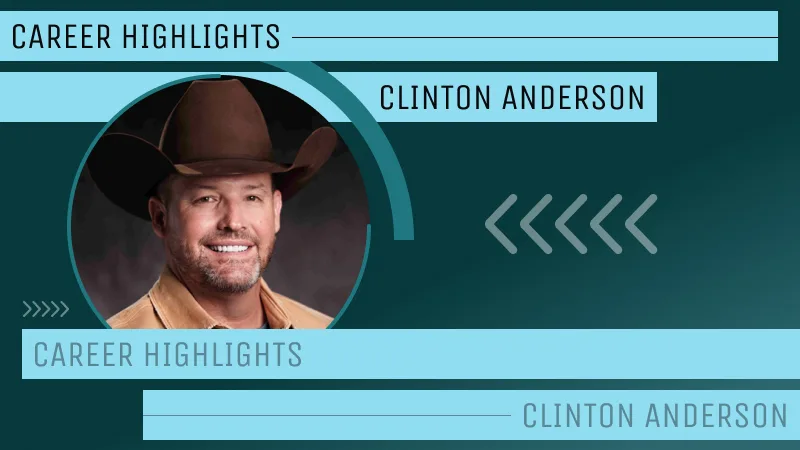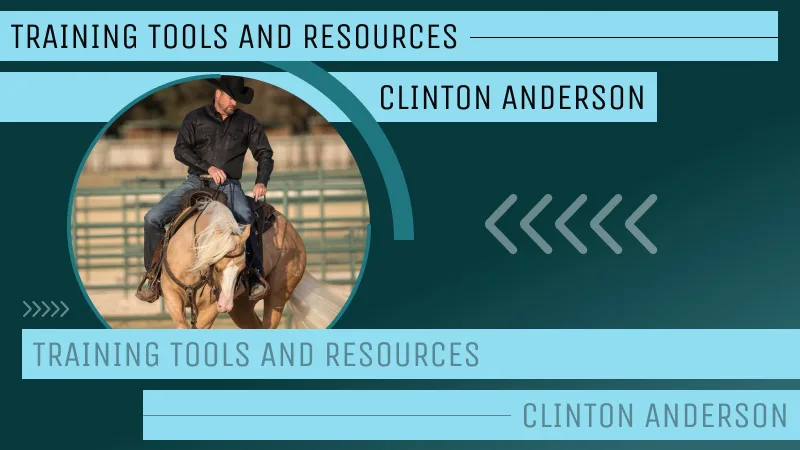Early Life and Background
Clinton Anderson was raised in all things horse down in Australia. Growing up in the countryside, Anderson became interested in horses and felled all his aspirations to train horses one day as he spent most of his youth around wild horse. Anderson grew up surrounded by the equestrian atmosphere; so it wasn’t long before his dreams about hip-hop were replaced with aspirations of “ones who got away,” except they have four legs and go neigh. Developing an interest in alternative training methods, he spent time with many respected trainers with a long-lasting influence on David such as Ian Francis and Gordon McKinlay.
Anderson discovered as a youth the understanding of language (behavior), respect, and trust in working with a horse. Over time, he discovered methods of connecting with horses below that surface level which would eventually develop into his Downunder Horsemanship method. Clinton started his formal training as a teen, then worked at barns and took lessons with riders on horses. Early on, he honed his craft and developed a name for himself as a horseman focused on developing the bond between owners and their horses.
The Australian upbringing there gave Anderson an abiding respect for nature and a discipline to think about the lessons of nature, which certainly played some part in his training philosophy. Clinton Anderson may sound familiar, and it should — here is a horseman that started small with nothing more than an obsession and the drive to grow, learn and train horses.
The Downunder Horsemanship Method:

The Downunder Horsemanship method has revolutionised the way horses are trained across the globe. Basically however, this training method revolves around respect for the horse and control coupled with communication primarily between the man riding on its back. The foundation of a great horse, Anderson contends, is training that is derived from steps and exercises followed through consistently, which is what makes the Downunder Horsemanship method so effective.
Flexibility is one of the key features of this method. Learn to turn whatever training facility you may have access to—whether a barn, round pen or the back 40—into an ideal place for your horse to absorb lessons. Clinton Anderson shows how. Saddle training – saddle exercises, and groundwork instills trust and confidence which solve many common issues horse owners face. Anderson’s methods, site training techniques that stress repeating maneuver after maneuver until the horse learns and plays along with him and patiently drilling his rider to think like a cowboy.
Even more so, the Unique Feature of the Downunder horsemanship method is its accessibility. With a complete offering of study kits, horsemanship clinics and videos, Clinton has made his techniques accessible to riders no matter their experience level. Through walkabout tours and horsemanship clinics around the U.S., he has introduced thousands of riders and horse owners to his effective training methods. His method has encouraged a wide number of horse-women (and men) to embrace his spiritual approach and elevate their abilities as trainers.
Clinton Anderson’s Career Highlights

As both an Australian native and accomplished horseman, Clinton Anderson has certainly found his way in the equine industry. Anderson, who grew up in the countryside, developed an early interest in horses and spent most of his childhood dreaming of training wild horses. Growing up surrounded by the horses and grappling with situations of working around them, Anderson learned a lot about them so that he could drive those dreams towards practicing horsemanship as soon as possible. Brendan’s curiosity led him to experiment with various approaches and study under respected trainers Ian Francis and Gordon McKinlay who were instrumental in developing his horsemanship style.
Anderson learned as a boy that a horse is best dealt with by learning its behavior, mutual respect and trust. Over time, he started developing methods to better communicate with horses on a different level which was the building blocks of his Downunder Horsemanship method. Clinton started formal training in my teenage years, working at training facilities, and getting experience with riders and horses. These formative experiences gave him the opportunity to hone his skills and establish himself as a horseman committed to developing relationships between horse owners and their animals.
Anderson brought with him a strong mentality and respect for nature that he was sleeked to his training philosophy which stemmed from growing up in Australia. Clinton Anderson, a household name in the world of horsemanship, went from humble beginnings to achieving international success through hard work, dedication, and love for all things horse and horse training.
Training Tools and Resources Developed by Anderson

Downunder Horsemanship, created by Clinton Anderson, offers a comprehensive range of training tools and resources designed to improve communication and performance between horse and rider. These tools include instructional books, DVDs, and an extensive online library aimed at equipping horse owners with practical techniques and strategies for effective training. Anderson’s methods emphasize clear, step-by-step guidance, making it accessible for riders of all experience levels.
The collection of training materials has received positive reviews for its practicality and effectiveness. Many users report significant improvements in their horse’s behavior and responsiveness after applying Anderson’s methods. The availability of these resources in multiple formats ensures accessibility for a wide audience, solidifying Downunder Horsemanship’s reputation as a go-to resource for horse training and care
Controversies and Criticisms

Regardless of this, Clinton Anderson’s career has experienced some angry whippersnapper moments. His Downunder Horsemanship method has satisfied many, but there are horsemen who question its training practices. Still other methods, especially on touchy horses can sometimes be a bit harsh or over the top. This kind of thing has kicked off a debate amongst critics within the horse training world.
Such events raise questions about the availability of top-level competitions in which firm discipline and compassion are both on display.
However, Anderson has taken such criticisms in stride, pointing out that his methods are a natural development based largely on the understanding of horse psychology and respect for horses. He says when asked by critics that he thinks his way results in a rider/horse relationship better grounded and more respectful than only when perfect behaviour of the horse is on display. Indeed, all kinds of owners from ex-racehorse trainers, exercisers and leaders of pony clubs have witnessed its success; the results speak.
That being the case, Anderson is still a recognized authority within the horse world. His ability to explain and justify the rationale behind his techniques, in flowing deeply-held opinions has also won him respect from many horse owners and trainers. They feel that he is a broad-minded, enthusiastic devotee of the finest principles of horsemanship.
While the discussions surrounding his techniques have not necessarily limited his influence, they do show how much passion and variation exist within the equestrian community.
The Influence Of Clinton Anderson On Horsemanship Today
Clinton Anderson has been the driving force behind a revolution in horsemanship that has taken place, at his hands, both nationally and internationally. Downunder Horsemanship, the way he teaches has moved the whole natural horsemanship movement in a direction that prescribes a relationship based on mutual trust and understanding between horse and owner. Thanks To Anderson, the gentle method of training he advocated in books has spread among many horse owners.
Even beyond his own individual work, Anderson has also impacted others who have incorporated aspects of his philosophy into their own programs. He has been recognized as an influence on their philosophies of training by trainers including Warwick Schiller and. His walkabouts and clinics that have been carried in digital format to an international audience of equestrians, along with his accessible presentation of techniques, has raised the standard for horse training worldwide.
Personal Life and Legacy
Aside from his career, Clinton Anderson lives the life that he wants to live with personal interests and philanthropy. Anderson’s journey is an example of his dedication to the horse industry. He has donated to many charitably causes, including to help support up and comers and also offers funding for (aspiring) trainers. His philanthropy is an embodiment of the belief that a career supported by so many should in turn be returned to, building on taught knowledge and given practical environment for equine ownership ensuring generations continue to enjoy both horse and rider.
The legacy of Anderson is the power, innovation and education. He has made an impact on horsemanship which transcends the methods employed and promotes horse owners worldwide to forge a better bond with their horses. An indelible voice to the horseman within the clinician, mentor and innovator that is Clinton Anderson.
Conclusion
If we look at the career of Clinton Anderson, we see a story that intertwines tradition with innovation. Whether he was training kangaroo horses back in Australia or his meteoric rise to worldwide fame with the Downunder Horsemanship method, Anderson has never stopped reaching for the ceiling when it comes to horse training. And the tools, techniques and self-education materials he has created, have helped thousands of horse owners fulfill their horsemanship dreams at home—or on the ranch—and his effect on the natural horsemanship movement has influenced all of what we know of our field.
As for Anderson, her agenda highlighting the equestrian world is far from quieting down. With his continuing contributions to clinics, digital content, and charitable projects, he will influence generations still to come.

